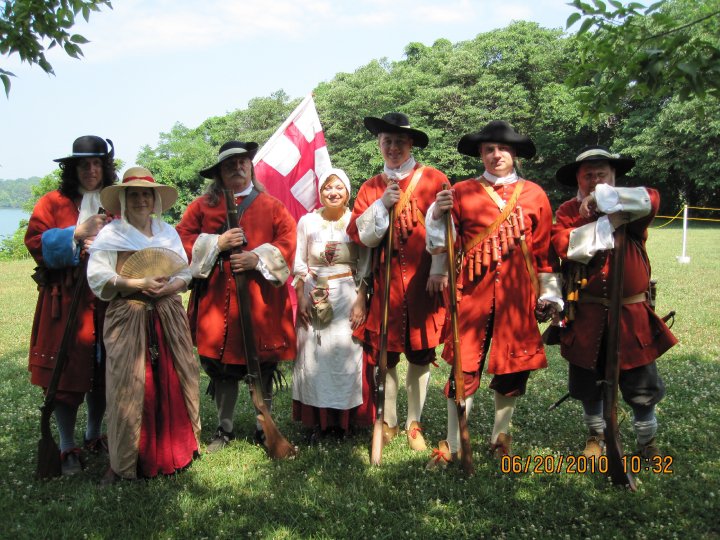The Kent County Militia, 1660-1707

Flag of the Dutch West Indies Company
We are a reenactment group primarily seeking to portray a militia company and their families in the colony of Maryland between the years 1660-1707. We have had the privilege of participating in events at our beloved St. Mary’s City in Maryland, Lewes and New Castle in Delaware, and Marietta Mansion, Maryland. Despite the similarity of clothing there is no intention to portray a uniformed company. The absence of a uniform is not only historically authentic, it also allows for us to join and be joined by other late 17th century reenactors and portray any militia organization of the period. We just might turn pirate if the company is to our liking! While we seek to keep our standards both high and reasonable, we will help those who wish to join us to meet them. We welcome any and all who share our interest in the late 17th century American colonial experience.
We are honored to be the sole American contingent of “The Honourable Company of Foote,” an Irish, cross border, non-profit organization to promote the awareness of Irish military history.
Particulars of the impression
Firearms
This was a period of transition from matchlocks to firelocks for the Army and the Regiment therefore acceptable to turn out with either firelocks or matchlocks. The shape and lines are of no consequence, given the early stages of this impression, as long as it is a full sized musket.
Bandolier of “boxes” or cartridge box
The bandolier became outdated inn European armies by the 1680’s but may have continued to be used in the colonies. It should be made of vegetable tanned leather with 12 to 15 “boxes”, a bullet bag, and priming flask. Cartridge boxes worn over the shoulder or on the waist belt are viable alternatives.
Sword, Sword Baldric, and Sheath
The sword should be a plain hilted short sword described as “a good stiff tuck” during the Great Civil War. A good source for blunted swords, suitable for actual use in mock combat is either Bailiff Forge or Armourclass, both in the UK. Baldric and sheath should be of vegetable tanned leather. If you do not have the correct sword, it is far better to turn out without one.
Men’s clothing
The coat is a long wool or linen garment approximately knee length, wide sleeved and deep cuffed with pewter, cloth, wooden or bone buttons from the collarless neck down the entire length of the coat. Pocket flaps are generally low. Sleeve lengths were alternately high and low on the arm but we suggest a sleeve ending above the wrist bone. The shirt is an almost knee length linen garment with full sleeves and a narrow band collar and pewter, cloth, wooden or bone buttons. A cravat was generally worn with the shirt. Knee britches are wool or linen, generally worn low on the waist and full in the leg. Hose are knee length or higher stockings are worn in a variety of colors. Shoes are brown or black and tie with a single lace or ribbon.
Ladies’ Clothing
The chemise is a neck to knee length or longer linen
undergarment/nightgown of the period. It has a drawstring neck and cuffs.
The sleeves are three-quarter length or longer, but would have been pushed
up to elbow length in period. The petticoat is a drawstring skirt made of
linen or wool or a linen/wool combination (linsey woolsey) that extends
from the waist to the ankle or just above the ground. The linen or wool
bodice, with or without sleeves, and or sleeved jacket was worn in
combination with the petticoat over the shift, and was worn by lower
middle class ladies.
Stays or semi-boned jumps are worn under the bodice or jacket. The
hat was either a man’s low crowned broad brimmed hat or straw hat, worn in
combination with a linen cap, with or without lace, or linen or silk hood.
Hose Knee length or higher stockings are worn in a variety of colors
and can be ‘clocked’ (embroidered at the ankle). Shoes Black or brown
smaller men’s latchet shoes could be worn or pointed toe shoe with low
heels closed with a ribbon would have been worn, as well as wooden and
leather clogs
Miscellaneous
Equipment such as haversacks, knapsacks, tents, eating utensils, plates, flagons, canteens, furniture, etc., are available from a variety of sources. Some things are authentic and some are not. Ask us before buying.
